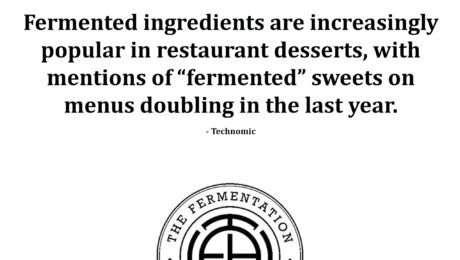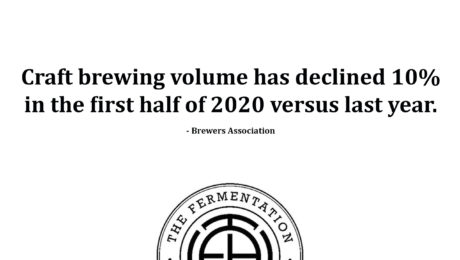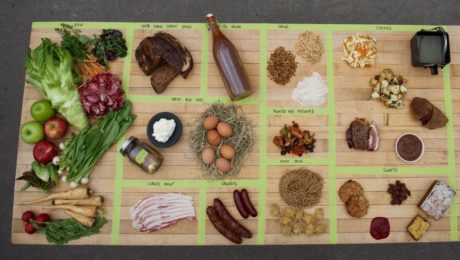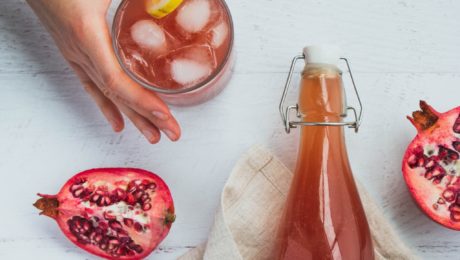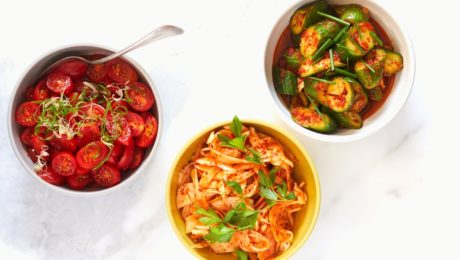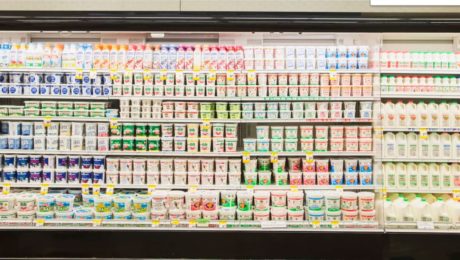Fermented Sweets Topping Dessert Menus
Fermented ingredients are increasingly popular in restaurant desserts, with mentions of “fermented” sweets on menus doubling in the last year. – Technomic
- Published in Business, Food & Flavor
Sour Sells
American’s flavor choice of 2020: the funkier, the better. Fermentation reigns as sour becomes a selling point. A new article in Yahoo Life highlights fermented food and drink ancient roots and modern revival. A naturopathic doctor, kombucha brand leader, food influencer, wine shop owner and chef/owner of two Korean restaurants share their thoughts on why people love the “interesting and complicated” flavors of fermented food. Fermentation delivers on gut health benefits, is made with clean, unprocessed ingredients, preserves seasonal ingredients and “tells a story.”
The article continues: “They’re nuanced, many-layered. Kimchi and sourdough alike smack of acid and sour-sweet brine, even for those of us with less-than-refined palates. They taste like the process of aging. And while the wellness revolution would have us believe that fermented food’s uptick in popularity is merely a product of the fact that we’re eternally prepared to flirt with anything that just might make us feel better, the phenomenon cuts deeper than that. There’s something to be said for flavor that comes with a narrative — that tastes of its own timeline.”
Read more (Yahoo Life)
- Published in Food & Flavor
Bubbling Over: More Interest in Fermentation Workshops?
Consumer reports indicate a spike in interest from the general public in fermentation during the COVID-19 pandemic and quarantine. But we wanted the experts to weigh in on whether or not attendance is up at their fermentation classes. We spoke with three chefs dispersed around the globe. Kirsten Shockey (chef and author at Ferment Works and TFA Advisory Board member) in Oregon, Nena Foster (chef at Nena Foster Food) in London and Ken Fornataro (chef at Cultures Group) in New York.
Kirsten Shockey, Ferment Works: “This is an interesting question. I do know that interest in purchasing fermented products is way up, however interest in workshops is less clear to me. As a fermentation educator, I can tell you that my full schedule disappeared by the nature of in person classes being no longer possible. I think there has been a shift, which was especially true during spring when people were at home and had the time and were focused on sheltering in place. The place that I saw a lot of interest in the spring was online live fermentation festivals on Instagram. Thousands of people dropped in because it was something to do, free and people are more interested in their immune system than ever before. This past month a European study came out looking at the “Association between consumption of fermented vegetables and COVID-19 mortality at a country level in Europe.” I have seen this pop up on both honest and not-so-honest clickbait headlines. Yet, as I write this, and the COVID cases are climbing, and we have something more concrete to point to, I am, personally, seeing less interest in learning. I suspect this is because people are trying to claim some normalcy of their summer and don’t want to spend so much time online. I think that when fall approaches, learning to ferment will take off.”
Nena Foster, Nena Foster Food: “I can’t say for certain, but I do think more people are starting to take an interest in making their own fermented foods. Maybe it’s because Lockdown has given people more time in the kitchen and more time — more time to use up what’s knocking about in their fridges, time in the kitchen and time to plan meals and waste less of what comes in their weekly veg boxes. Or maybe it’s because, the fear of a virus that seems to prey on those with pre-existing health conditions as well as those who are seemingly healthy, means people are taking more notice of and interest in maintaining their health. I also think the links between the gut and mental well-being have sent a few people to my sessions, as emotionally and mentally this has been a tough time for most and even more so for those who already struggle with their mental health. I think fermenting also takes us back to a simpler, slower pace of life and reminds us to slow down, something we all desperately needed to do and was forced by the pandemic.
Based on my own workshops, I seem to be getting a slightly younger, more kitchen-curious demographic than when I ran face-to-face sessions. I think the reasons they come to my sessions very much mirror the above. I was very conscious of being able to move my work online because I knew that the support in terms of health-focused cooking and fermented foods was needed more now than ever, and I am pleased that I have.”
Ken Fornataro, Cultures Group: “It’s been a long time coming. Are more people buying fermented foods because they want to believe they can prevent or even treat Covid-19? Maybe they are bored with the food they have BEEN eating, and have decided to try out that fermented food thing that keeps trending on social media.
A lot of it may be due to long term marketing efforts finally hitting home. In addition to fermented products, some just inferior products mixed with microbes, people are snapping us lots of things with perceived health benefits.
It’s impossible to avoid examination of one’s diet, and one’s health status during this international pandemic. People seem to get that processed foods typically are lacking if not harmful.
But do they like what they are trying? Or is this about the desire to establish a normalcy and feeling of safety that their grandma’s strange smelling foods, once considered embarrassingly ethnic, and to go to a time and place they call home? Tasting home, tasting freedom?
People are desperately looking for alternatives to the current reality.
Sales of raw ginger, turmeric, roots and wild forged plants to make teas and elixirs – almost anything that is believed to be acidic or cleansing to assuage the psychological anxiety that comes from feeling threatened but not knowing what to do about it – have also skyrocketed during this pandemic.
Do fermented foods actually contribute to someone’s health, especially their immune system health? Directly? Highly doubtful. Indirectly or holistically, without a doubt.
If eaten in the context of healthy living patterns including getting adequate rest, access to a clean environment, not smoking, and eating moderate amounts of any fermented such as kimchi or sauerkraut or natto that replaces some processed, chemical and additive laden food you used to eat is of definite benefit.
Fermented foods should be considered as the ultimate condiment or accompaniment to whatever ingredient you have. They can add intense flavor dimensions to otherwise plain tasting foods while adding prebiotics and probiotics and increased nutritional value and increased digestibility.
A couple of tablespoons of sauerkraut or kimchi or natto or miso or shio-koji on top of a bowl of noodles or rice or beans or mixed into a salad is easy.
But fermented foods can also be served on the side, an extremely important consideration when eating with people with different tastes and different sensitivities.
Fermented foods are tasty, sometimes an acquired taste. And healthy, especially if it gives you time to do yoga or exercise. Which surely helps you sleep better. Which helps you maintain your health.”
- Published in Business
Craft Brewing Volume
Craft brewing volume has declined 10% in the first half of 2020 versus last year.
Brewers Association
- Published in Business
Organic Food Sales
Organic food sales reached $50.1 billion in 2019, while organic nonfood — including dietary supplements, personal care items, textiles, household cleaning products, pet food and flowers — hit $5 billion in sales. – Organic Trade Association (OTA)
- Published in Business
Fermentation Helps Blue Hill Support Farmers
In an effort to help struggling farms during the coronavirus pandemic, Blue Hill at Stone Barns is expanding their fermentation program.
The upscale restaurants (Blue Hill in Manhattan and Blue Hill at Stone Barns in Westchester County) have long been at the forefront of farm-to-table dining. But, like all restaurants in New York, Blue Hill closed in March when the coronavirus pandemic broke out. Though co-owners Dan and David Barber are confident the traditional restaurant model will once again return, the brothers are troubled by the catastrophic impact on farms.
Blue Hill Farm and Stone Barns Center (a non-profit farm and educational center) have partnered to form a new entity resourcED, which surveyed over 500 farmers. A key conclusion — over a third of farms will not survive the pandemic. August sales at farms are expected to be down by 50% due to the COVID-19 pandemic, and over 30% of farmers say they are struggling to cover expenses.
“The excess product is a huge concern. That’s shaped our box program, our fermentation program,” says Andrew Luzmore, Blue Hill’s market forager.
The resourcED survey was the impetus at Blue Hill to launch their picnic dining and box program. Diners can buy a picnic dinner and eat a farm-to-table meal on the farm’s patio or lawn (physically distanced from others), still allowing Blue Hill to purchase food from local farmers. This program allows consumers to pick-up a box full of produce, dairy products, seafood or meat, all sourced from local farms.
Blue Hill’s mainstay fermentation and preservation programs, used for over 15 years to maintain food flavor and nutrients through long Northeastern winters, have also been expanded, to absorb more of excess farm production.
“The focus on preservation program is bred out of necessity, and necessity breeds creativity,” says Cortney Burns, chef, fermentation consultant for Blue Hill and author of “Bar Tartine, Techniques & Recipes” and the forthcoming “Nourish Me Home.” “What we’re doing now with fermentation at Blue Hill rides on the coattails of what has been part of the backbone of Blue Hill for years. Working here has me looking at fermentation through a different lens these days. How can we be completely in service to good agriculture? How can we create a greater economy for farms?”
Adds Luzmore: “The fermentation program has definitely expanded a lot. We’re shifting more to helping farmers with excess product.”
For example, Blue Hill recently purchased napa cabbage that would have been wasted from a Hudson Valley farmer. They are fermenting the cabbage, “making a delicious, nutritious probiotic-rich food for our diners, whilst buying up overabundant harvests,” Burns notes.
It’s conscious cooking, Burns says “We’re not just buying for the sake of preservation. We want to create variety.” Another example is how the Stone Barns Center is trialing preserving different beet varieties.
Fermented grapes and capers, buckwheat vinaigrette, peach umeboshi and whey tonic are among the creations Blue Hill has served picnic-style and in boxes. Some of the fermented food being offered is purchased from local farmers. Local cultured dairy — such as farm fresh cheese and yogurt — makes up a large percentage of their dairy box, for example.
“There are all these different ways we’re harnessing the power of fermentation,” Burns says. “We’ve had to shift our expectation of a restaurant kitchen. We need to make sure that first, the food doesn’t spoil, and second, that we have lots of probiotic rich food loaded with flavor to serve people.”
A picnic meal at Blue Hill is $195 per person and the boxes range from $45 to $170. Blue Hill is also donating boxes to families with food insecurities.
Luzmore hopes other restaurants will innovate ways they can support local farms during the pandemic. “It’s almost impossible to buy exactly the amount a restaurant needs, especially now when there’s a greater need to support farms. Considering the constant and changing flux of product coming into the restaurant for the boxes and donations, fermentation allows for a more holistic approach of using excess product.”
“Chef Dan [Barber] has said many times throughout the launch of resourcED: we’ve kind of gone from being a restaurant to a food processing facility. Blue Hill is a fine dining restaurant. We still maintain that mentality and quality, but it’s at a different level. The scale, we’re now thinking of purchasing pallets instead of pounds.”
- Published in Business
Hard Kombucha is 2020’s Summer Drink
Hard kombucha is the drink trend of 2020, declares lifestyle and news publication Well + Good. Calling hard kombucha “your new summer drink of choice,” the publication points out that the fermented tea has less sugar and fewer carbs than traditional beer, wine and cocktails. Hard kombucha is made by adding more sugar and more yeast to the SCOBY than traditional kombucha, yielding a drink with a higher alcohol content.
Read more (Well + Good)
- Published in Business, Food & Flavor
Kimchi is the New “It Girl” Pantry Staple
From the New York Times: “Outside Korea, it took at least 100 more years for kimchi to go from so-called spoiled stink to it-girl pantry staple and poster child for gut health. Today, some would say that it’s not just a cornerstone of Korean cuisine; it is Korea itself.” Kimchi, the article declares, is a verb. Kimchi is a traditional fermented cabbage dish, but encompasses “a much larger world of dishes you can find on any given Korean table.”
Read more (The New York Times)
- Published in Business, Food & Flavor
6 Trends for Non-Alcoholic Fermented Drinks
When consumers buy beverages today, they want drinks that go beyond simply quenching thirst. Drinks today need to meet consumer’s health needs, too — improving sleep habits, aiding gut health, lowering stress levels and boosting energy.
“There’s this real explosion of outcome-based beverages in the industry at the moment,” says Howard Telford, head of soft drinks for Euromonitor International. “Ten years ago, it was easy to identify what was an energy drink. That’s no longer the case, clearly. Because every category now has some form of products on the shelf with a functional proposition. These ingredients-based category lines are blurring. Consumers are rethinking what’s our morning option, what’s our late afternoon option, what’s our evening beverage.”
Clean ingredient lists with functional appeal will differentiate brands. In a beverage trends webinar hosted by FoodNavigator, brand leaders in the beverage industry shared their insight. Here are six beverage trends for 2020:
1. More Consumer Need States for Different Ingredients
Modern beverages straddle between food and dietary supplements.
“Every time (consumers) spend a dollar on a drink or a food item, they want that food or drink item to do more for them,” says Chris Fanucchi, co-founder of drink brands Limitless and Koia. “Brands are starting to put more marketing on the front of their labels, that say ‘Hey, we help you with calming you or with inflammation or with pain or anxiety.’ As consumers start to see that more and more, they’re going to start to expect that. And the second they start to expect that is when the consumers are going to be demanding that their beverages have more and more function to them. So a functional beverage right now I think is definitely about identifying those need states that are more relevant to consumers today.”
2. Mindfully Purchasing Natural Health Products
Consumers are looking for ingredient lists without artificial ingredients (33%) and with limited or no sugar (35%), according to research by Euromonitor International. Sixty percent are following diets – lowering carbs and saturated fat, monitoring weight and tracking calories.
Holly McHugh, marketing associate with Imbide, thinks consumers will seek out healthier products at the end of the coronavirus pandemic. “Like a detox that you see in January because people have overindulgences over the holidays…I do think there will be a bump when people go back to their normal lives.”
“There’s absolutely a stigma against sugary products for your overall health. And people are really concerned about their health right now,” McHugh says.
However, McHugh doesn’t think brands will completely abandon sugar. Instead she hypothesizes brands will provide more options. Like a full-sugar, low-sugar and no-sugar drink, then drinks with alternative sweetener like stevia and natural sweetener like honey.
3. Rise of Cannabis/Hemp in Beverages
Consumers are experiencing mounting stress due to the pandemic and are seeking drinks with stress-reducing ingredients.
Estimates show legal cannabis sales will rise to $150-170 billion by 2023 according to Euromonitor International, mostly from North America. Huge innovations in CBD industry as proving hemp-derived drinks is a growing market. CBD-infused beverages grew by 500% last year.
“I think CBD is going to be a very big category,” adds Thomas Hicks, chief growth officer for Ojai Energetics, which produces various CBD products, including a CBD drink. “The consumer demand is phenomenal and you can see that online. About 90% of our business is direct to consumers.”
Ojai Energetics has seen sales increase 20% during the pandemic.
CBD is poised to become as big of a category as energy drinks. However, more clarity around CBD needs to be provided by the Food & Drug Administration. Thomas notes the FDA has not yet defined the different elements of CBD.
“It’s a race to the bottom if you don’t have really good branding and, quite honestly, a patented process,” says Hicks, who has formerly worked with big drink giants like Hansens and Coca-Cola.
4. Cost Major Factor During Health, Economic Crisis
Brands looking to add more premium ingredients to their drinks need to note consumer’s pocketbooks. Howard Telford, head of soft drinks for Euromonitor International, said he predicts certain drink categories will decline because of cost in a COVID-19 era.
“This event (coronavirus pandemic) is translating to an economic crisis more than a public health crisis, I think we have to be very cognizant of price,” he says.
Comparing sales during the 2008 Great Recession, Telford says consumers will trade down premium products. “Affordable luxury” needs to be the focus of new drink launches, adds McHugh.
“I think cost will be a really important consideration given the uncertainty of the economy right now,” McHugh says. “Brands will need to introduce products that are affordable and meet those clean, quality, functional qualities during this time.”
5. Brands Need to Better Educate Consumers
As more consumers routines are impacting during the outbreak and they turn to healthy eating during, will they turn to kombucha over Coke? Telford believes so. Long-term, consumer’s beverage choices will change because of COVID-19. They’re reducing sugar, trusting health ingredients.
“When we decide to indulge, we’re conscious of the ingredients in those products,” he adds.
Especially CBD.
“There’s still so much education around CBD with the general public,” Hicks adds.
Research provides CBD helps regulate the immune system, and consumers are becoming savvier and seeking out that research, Thomas says. Key, he adds, is researching the specifics behind CBD brands. Brands should publish their lot number certification online. Consumers should easily be able to research CBD batches should go through two different labels to make sure they are acceptable and organic, he advises.
6. Shelf Brand Launch Until Post Pandemic
Faccuchi, who sold Limitless to Pepsi/Keurig last year, said smaller companies are struggling securing capital to launch. An entrepreneur, Faccuchi invests in beverage companies.
“Lots of clients, especially in the energy category, are having zero luck with retail meetings, confirmation of placement on shelves,” Faccuchi says. “They’re seeing around waiting for those opportunities. It makes it all the more difficult when there’s really no light at the end of the tunnel. These brands could lose a lot of cash over the next several months, they could go belly up.”
His advice to people wanting to launch a new beverage company: “Make sure the category you’re jumping into actually has a need. I run into a lot of entrepreneurs who build this awesome product out of different ingredients that you’d never hear of, and the unfortunate truth is some of those ingredients are just not supply chain ready. So you can’t get the price point necessary for consumer to actually try the brand, which is the No. 1 thing when you’re launching a new company. So make sure you’re identifying a need space that people actually have. Your best way to test that is online marketing.”
Find people in food and beverage industry that are looking to champion brands, he advices. “Those people do exist.”
Future Trends in Yogurt
Yogurt’s evolution in America mirrors the country’s food culture. From the sugar-filled yogurt of the 80’s to the fruit-on-the-bottom cups of the 90’s to protein-heavy Greek yogurt of the 2000’s to artisanal styles (Icelandic, French, Australian) of the early 2010’s to the non-dairy varieties of the late 2010’s and to the current trend of low-carb, high-fat, keto-friendly yogurt. Americans used to scoff at tart-tasting yogurt — now it’s embraced and sugar-filled yogurt is shunned.
“With yogurt occupying more and more shelf space in grocery stores — and tracking so closely with American diet habits — companies are constantly trying to figure out what’s going to be big in yogurt,” reads the article. Experts are betting on yogurt made with cold-brew concentrate and protein-rich, dairy-free yogurt made with with synthetic proteins.
Continues the article: “(Frank Palantoni, former vice president of marketing for Dannon) compares what has happened with American consumers and yogurt to what happened with wine. ‘Americans have a very limited receptivity of their palate to new flavors,’ he says. But once given options, with different tastes and textures, ‘you will eventually develop your palate and it will get more sophisticated.’ The variety in yogurt has made many people more adventurous eaters. As packed as the yogurt aisle seems, expect even more wide-ranging offerings in coming years. And that, he adds, is a good thing.
Read more (Vox)
- Published in Business

